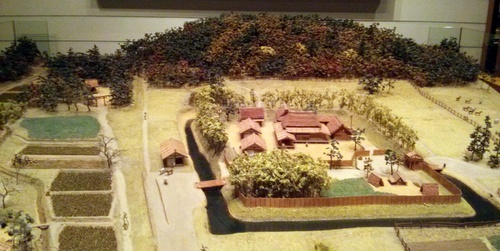Difference between revisions of "Ichijodani castle"
| Line 1: | Line 1: | ||
| + | [[File:Asakurayakata.jpg|right|thumb|500px|A scale model of the Asakura yakata, at the National Museum of Japanese History]] | ||
*''Built:[[1471]]'' | *''Built:[[1471]]'' | ||
*''Type:Flatland-Mountain'' | *''Type:Flatland-Mountain'' | ||
| Line 8: | Line 9: | ||
Ichijôdani, also known as Asakura-yakata, was an [[Asakura clan]] fortress in [[Echizen province]] which [[Oda Nobunaga]] seized in [[1575]]. It is said that after [[Asakura Yoshikage]] fled for Ôno, the fortress burned for three days. | Ichijôdani, also known as Asakura-yakata, was an [[Asakura clan]] fortress in [[Echizen province]] which [[Oda Nobunaga]] seized in [[1575]]. It is said that after [[Asakura Yoshikage]] fled for Ôno, the fortress burned for three days. | ||
| + | |||
| + | The fortress is said to have closely resembled that of the [[Kamakura shogunate|Kamakura shoguns]] in general layout,<ref>Gallery labels, Rekihaku.[https://www.flickr.com/photos/toranosuke/11737415975/in/dateposted-public/]</ref> and might be taken as a representative example of typical samurai ''yakata'' of the time. The compound was surrounded by a moat, and included within it the lord's residence, ''tai no ya'',<ref>Small additional buildings connected to the main residence by covered corridors.</ref> kitchens, and retainers' residences, known as ''samurai-rô'', as well as small buildings used by lower retainers (''genin'') for various everyday tasks. Surrounding the fortress were pastures, fields, shrines and temples associated with the clan, and the homes of other retainers.<ref>"Representative Warrior Residence of Eastern Japan, 13-14th c.," gallery labels, Rekihaku.[https://www.flickr.com/photos/toranosuke/11737400955/in/dateposted-public/]</ref> | ||
Following archaeological surveys begun in 1971, some parts of the castle have been rebuilt. | Following archaeological surveys begun in 1971, some parts of the castle have been rebuilt. | ||
| Line 17: | Line 20: | ||
*''[[Nihon no Meijo|Nihon no Meijô]]'' | *''[[Nihon no Meijo|Nihon no Meijô]]'' | ||
*Terada Shôichi (ed.) ''Meijô wo aruku 2: Kanazawa-jô''. Tokyo: PHP Kenkyûsho, 2002. | *Terada Shôichi (ed.) ''Meijô wo aruku 2: Kanazawa-jô''. Tokyo: PHP Kenkyûsho, 2002. | ||
| + | <references/> | ||
[[Category:Castles]] | [[Category:Castles]] | ||
[[Category:Sengoku Period]] | [[Category:Sengoku Period]] | ||
Revision as of 08:34, 19 November 2015
- Built:1471
- Type:Flatland-Mountain
- Founder: Asakura Toshikage
- Destroyed:1575
- Location:Echizen province
- Other Names: 朝倉館 (Asakura-yakata)
- Japanese: 一乗谷城 (Ichijoudani-jou)
Ichijôdani, also known as Asakura-yakata, was an Asakura clan fortress in Echizen province which Oda Nobunaga seized in 1575. It is said that after Asakura Yoshikage fled for Ôno, the fortress burned for three days.
The fortress is said to have closely resembled that of the Kamakura shoguns in general layout,[1] and might be taken as a representative example of typical samurai yakata of the time. The compound was surrounded by a moat, and included within it the lord's residence, tai no ya,[2] kitchens, and retainers' residences, known as samurai-rô, as well as small buildings used by lower retainers (genin) for various everyday tasks. Surrounding the fortress were pastures, fields, shrines and temples associated with the clan, and the homes of other retainers.[3]
Following archaeological surveys begun in 1971, some parts of the castle have been rebuilt.
Link
- Fukui city(Ichijodani ruin live camera)
References
- Nihon no Meijô
- Terada Shôichi (ed.) Meijô wo aruku 2: Kanazawa-jô. Tokyo: PHP Kenkyûsho, 2002.
